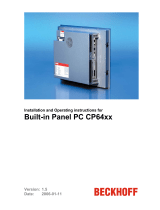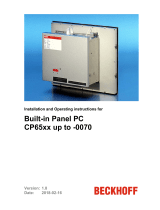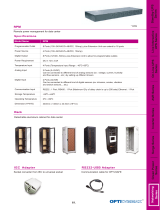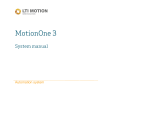Page is loading ...

Hardware Documentation
CX50x0
Embedded-PC
1.9
2017-03-30
Version:
Date:


Table of contents
CX50x0 3Version: 1.9
Table of contents
1 Foreword ....................................................................................................................................................5
1.1 Notes on the documentation..............................................................................................................5
1.2 Safety instructions .............................................................................................................................6
1.3 Documentation issue status ..............................................................................................................7
2 Product overview.......................................................................................................................................8
2.1 Intended use......................................................................................................................................8
2.2 System Overview...............................................................................................................................9
2.3 CX5010 - Technical data .................................................................................................................11
2.4 CX5020 - Technical data .................................................................................................................12
2.5 Types...............................................................................................................................................13
2.6 Architekture overview ......................................................................................................................15
2.7 Battery compartment .......................................................................................................................17
2.8 CF slot .............................................................................................................................................19
2.9 CF card............................................................................................................................................20
3 Assembly and connecting ......................................................................................................................21
3.1 Unpacking, installation and transport ..............................................................................................21
3.2 Dimensions......................................................................................................................................22
3.3 Installation on the mounting rail.......................................................................................................24
3.4 Power supply ...................................................................................................................................26
3.5 Mounting of passive terminals to the power supply of CX50x0 .......................................................28
3.6 DVI-D connection ............................................................................................................................29
3.7 USB connections .............................................................................................................................31
3.8 LAN connections .............................................................................................................................32
3.9 RS232 connections (CX50x0-N030) ...............................................................................................34
3.10 RS422/RS485 connections (CX50x0-N031) ...................................................................................35
4 Operating/Configuration .........................................................................................................................36
4.1 EtherCAT cable redundancy ...........................................................................................................36
4.2 Switching on and off ........................................................................................................................40
4.3 Note on using the setup...................................................................................................................40
4.3.1 Standard CMOS Features ............................................................................................... 41
4.3.2 Advanced BIOS Features ................................................................................................ 45
4.3.3 Advanced Chipset Features ............................................................................................ 50
4.3.4 Integrated Peripherals ..................................................................................................... 52
4.3.5 Power Management Setup .............................................................................................. 57
4.3.6 PnP/PCI Configurations................................................................................................... 59
4.3.7 PC Health Status ............................................................................................................. 60
4.3.8 Frequency/Voltage Control .............................................................................................. 62
5 1-second UPS (persistent data)..............................................................................................................63
5.1 BIOS settings...................................................................................................................................64
5.2 Windows write filter..........................................................................................................................65
5.3 FB_S_UPS ......................................................................................................................................66
5.4 Mode and status of the function block .............................................................................................68
5.5 Checking the validity of the variables ..............................................................................................69

Table of contents
CX50x04 Version: 1.9
5.5.1 SYSTEMINFOTYPE ........................................................................................................ 69
5.5.2 PlcAppSystemInfo ........................................................................................................... 71
6 Error handling and diagnostics..............................................................................................................72
6.1 Basic CPU module ..........................................................................................................................72
6.1.1 LEDs on the basic CPU module ...................................................................................... 72
6.1.2 LEDs of the power supply in K-bus mode........................................................................ 72
6.1.3 LEDs of the power supply in E-bus mode........................................................................ 75
6.2 Faults...............................................................................................................................................76
7 Decomissioning.......................................................................................................................................77
7.1 Disassembly and disposal ...............................................................................................................77
8 Appendix ..................................................................................................................................................79
8.1 Accessories .....................................................................................................................................79
8.2 Certifications....................................................................................................................................81
8.3 Support and Service ........................................................................................................................82

Foreword
CX50x0 5Version: 1.9
1 Foreword
1.1 Notes on the documentation
This description is only intended for the use of trained specialists in control and automation engineering who
are familiar with the applicable national standards.
It is essential that the documentation and the following notes and explanations are followed when installing
and commissioning the components.
It is the duty of the technical personnel to use the documentation published at the respective time of each
installation and commissioning.
The responsible staff must ensure that the application or use of the products described satisfy all the
requirements for safety, including all the relevant laws, regulations, guidelines and standards.
Disclaimer
The documentation has been prepared with care. The products described are, however, constantly under
development.
We reserve the right to revise and change the documentation at any time and without prior announcement.
No claims for the modification of products that have already been supplied may be made on the basis of the
data, diagrams and descriptions in this documentation.
Trademarks
Beckhoff
®
, TwinCAT
®
, EtherCAT
®
, EtherCAT P
®
, Safety over EtherCAT
®
, TwinSAFE
®
, XFC
®
and XTS
®
are
registered trademarks of and licensed by Beckhoff Automation GmbH.
Other designations used in this publication may be trademarks whose use by third parties for their own
purposes could violate the rights of the owners.
Patent Pending
The EtherCAT Technology is covered, including but not limited to the following patent applications and
patents:
EP1590927, EP1789857, DE102004044764, DE102007017835
with corresponding applications or registrations in various other countries.
The TwinCAT Technology is covered, including but not limited to the following patent applications and
patents:
EP0851348, US6167425 with corresponding applications or registrations in various other countries.
EtherCAT
®
is registered trademark and patented technology, licensed by Beckhoff Automation GmbH,
Germany
Copyright
© Beckhoff Automation GmbH & Co. KG, Germany.
The reproduction, distribution and utilization of this document as well as the communication of its contents to
others without express authorization are prohibited.
Offenders will be held liable for the payment of damages. All rights reserved in the event of the grant of a
patent, utility model or design.

Foreword
CX50x06 Version: 1.9
1.2 Safety instructions
Safety regulations
Please note the following safety instructions and explanations!
Product-specific safety instructions can be found on following pages or in the areas mounting, wiring,
commissioning etc.
Exclusion of liability
All the components are supplied in particular hardware and software configurations appropriate for the
application. Modifications to hardware or software configurations other than those described in the
documentation are not permitted, and nullify the liability of Beckhoff Automation GmbH & Co. KG.
Personnel qualification
This description is only intended for trained specialists in control, automation and drive engineering who are
familiar with the applicable national standards.
Description of symbols
In this documentation the following symbols are used with an accompanying safety instruction or note. The
safety instructions must be read carefully and followed without fail!
DANGER
Serious risk of injury!
Failure to follow the safety instructions associated with this symbol directly endangers the life and health of
persons.
WARNING
Risk of injury!
Failure to follow the safety instructions associated with this symbol endangers the life and health of per-
sons.
CAUTION
Personal injuries!
Failure to follow the safety instructions associated with this symbol can lead to injuries to persons.
NOTE
Damage to the environment or devices
Failure to follow the instructions associated with this symbol can lead to damage to the environment or
equipment.
Tip or pointer
This symbol indicates information that contributes to better understanding.

Foreword
CX50x0 7Version: 1.9
1.3 Documentation issue status
Version Changes
0.1 Preliminary version
1.0 First publication
1.1 Changes on system interface N031 and DVI resolution
1.2 Changes on temperature range and K-bus diagnosis
1.3 Requirements for power supply added
1.4 Notes on passive terminals and power supply added
1.5 Notes on K-Bus diagnosis added
1.6 UL requirements added
1.7 Architecture overview added
1.8 Chapter Types reworked
1.9 Chapter 1-second UPS reworked

Product overview
CX50x08 Version: 1.9
2 Product overview
2.1 Intended use
The CX5010 / CX5020 device series is a modular control system designed for top-hat rail installation. The
system is scalable, so that the required modules can be assembled and installed in the control cabinet or
terminal box as required.
Only switch the PC off after closing the software
Before the Embedded PC is switched off, the software currently running on it should be stopped properly in
order to avoid data loss on the hard disk. Please read the section on “Switching off [}40]”.
Switch off all system components and uncouple the Industrial PC from the system if the PC is not used for
control purposes, e.g. during a function test. To disconnect first pull the first terminal behind the power
supply unit (optional), then pull the connectors of the fieldbus connections.
System components that have been switched off must be secured against being switched on again.
The Embedded PC’s power supply unit must be supplied with 24 V
DC
.
NOTE
Damage to the environment or devices
Do not exchange any parts when under power! Replacing control components while the system is live may
lead to short circuits or overvoltages, which in turn may damage the controller and connected peripherals
(terminals, monitors, input devices etc.).
When components are being fitted or removed, the supply voltage must be switched off.
Software knowledge
NOTE
System malfunctions
Requires software knowledge! Each user must be familiar with all the functions of the software installed on
the PC to which he has access.

Product overview
CX50x0 9Version: 1.9
2.2 System Overview
The system
The CX5000 series devices are DIN rail-mountable, fanless Embedded PCs with direct connection for
Beckhoff Bus Terminals or EtherCAT terminals. In contrast to the other CX device families, the CX5000
series has a fixed, non-expandable number of system interfaces. The housing design for this series is
optimised for robustness and compactness. No modular expandability for the left-hand side is provided.
Although EtherCAT integration offers a wide range of expansion capability. Further master/slave fieldbus
connections (PROFIBUS, CANopen, DeviceNet) or communication interfaces (RS232, RS422/RS485) and
all other signal types accessible via EtherCAT can be directly connected as EtherCAT Terminals. Two
independent Gigabit Ethernet ports and four USB 2.0 interfaces are available. A Beckhoff control panel or a
commercially available DVI monitor can be connected to the DVI D interface. A serial port (RS232/RS422/
RS485) or a fieldbus connection with master or slave function can be added as an optional interface as
required. An interchangeable Compact Flash card located behind a flap that is accessible from outside is
used as boot and storage medium. The built-in capacitive 1-second UPS ensures secure backup of
persistent application data on the Compact Flash card. The date and time are buffered via a replaceable
battery. The operating system can be Windows CE or Windows Embedded Standard. The TwinCAT
automation software transforms a CX5000 system into a powerful PLC and motion control system that can
be operated with or without visualisation.
EtherCAT as a fast I/O system
Like all Embedded PCs from the CX series (except CX100x), the CX5000 was developed for optimum
interaction with EtherCAT. One of the two independent Ethernet interfaces of the CPU module (X001) is
intended for EtherCAT mode. The primary EtherCAT connection is generally established via terminals. Both
can also be configured as a ring in order to achieve line redundancy.
Interestingly, EtherCAT offers several options for connecting conventional fieldbus systems to the CX50x0:
As EtherCAT device in terminal form, for example the PROFIBUS master as EtherCAT Terminal EL6731. In
practice, this means that the PROFIBUS master can be positioned exactly where it is required within a
machine. It no longer has to be implemented as a plug-in card in the IPC or a master controller in the control
cabinet.
PLC, Motion Control and visualisation
As a DIN rail IPC and in conjunction with the TwinCAT software from Beckhoff, the CX50x0 offers the same
functionality as large Industrial PCs. In terms of PLC, up to four virtual IEC 61131 CPUs can be programmed
with up to four tasks each, with a minimum cycle time of 50 μs. All IEC 61131-3 languages can be used.
Moreover, functionalities are available for Motion Control applications, such as simple point-to-point
movements.
In addition to real-time execution of control tasks, the TwinCAT real-time kernel ensures that enough time
remains for the user interface (HMI), to communicate with the real-time components via software interfaces
such as ADS or OPC.

Product overview
CX50x010 Version: 1.9
For CX50x0 the familiar basic principle applies: it is a programming tool for all controllers.
The complete programming of PLC, Motion Control and visualization is transferable to all PC controls from
Beckhoff, which is reassuring in cases where it becomes apparent during a project that more processing
power is required after all. In this case a system with higher performance can be used.
Fieldbus interfaces
The fieldbus interfaces are currently available as master and slave versions for the following fieldbuses:
Optional interfaces:
The optional interfaces can be used to connect single-channel fieldbus interfaces. Operation is limited to one
interface at a time. If several fieldbus interfaces are required, they can be added as E-bus terminals
(EL67xx). The following fieldbus interfaces are available:
• CX50x0-N030 = RS232, D-Sub connector
• CX50x0-N031 = RS422/RS485, D-Sub socket
• CX50x0-M310 = PROFIBUS master, D-Sub socket, 9-pin
• CX50x0-B310 = PROFIBUS slave, D-Sub socket, 9-pin
• CX50x0-M510 = CANopen master, D-Sub connector, 9-pin
• CX50x0-B510 = CANopen slave, D-Sub connector, 9-pin
• CX50x0-M930 = PROFINET RT, controller, Ethernet (2 x RJ-45 switch)
• CX50x0-B930 = PROFINET RT, device, Ethernet (2 x RJ-45 switch)
• CX50x0-B951 = Ethernet/IP slave, Ethernet (2 x RJ-45 switch)
• CX50x0-B100 = EtherCAT slave, EtherCAT IN and OUT (2 x RJ 45)
The software
In combination with the TwinCAT automation software, the CX50x0 Industrial PC becomes a powerful IEC
61131-3 PLC with up to four user tasks. Additionally, Motion Control tasks can also be executed. Depending
on the required cycle time, several servo axes can be controlled. Even special functions such as flying saw,
electronic gearbox and cam plate can be realised.
The CX50x0 system is programmed in the same way as other bus controllers:
Remote programming via Ethernet
This option is used if the basic unit is equipped with “Windows CE.NET”. In this case, the system is
programmed via a laptop or a desktop PC, which is connected to the CX via Ethernet (network or crossover
cable). The programs are developed on the laptop with a standard TwinCAT software licence and then
loaded into the target device.
Visualisation
The Beckhoff OPC server is available for interfacing with SCADA packets, if the two operating system
variants “Windows CE.NET” or “Windows XP Embedded” are used. In other words, the CX50x0 also offers
straightforward visualisation and simultaneous control in real-time on a single system.

Product overview
CX50x0 11Version: 1.9
2.3 CX5010 - Technical data
The basic configuration of the CX5010 includes a 128 MB Compact Flash card. The basic configuration
includes two Ethernet RJ-45 interfaces, four USB-2.0 interfaces and a DVI-D interface.
Technical data CX5010
Processor Intel® Atom™ Z510 processor, 1.1 GHz clock
frequency
Internal Flash memory 128 MB Compact Flash card (optionally extendable)
Internal main memory 512 MB RAM (interior, not expandable)
Interfaces 2 x RJ 45, 10/100/1000 Mbit/s, DVI-D, 4 x USB 2.0
Diagnostics LED 1 x power, 1 x TC status, 1 x flash access, 2 x bus
status
Clock Internal clock with battery backup for time and date
(battery replaceable)
Operating system Microsoft Windows CE or Microsoft Windows
Embedded Standard
Control software TwinCAT PLC runtime or TwinCAT NC PTP runtime
Power supply 24 V DC (-15 %/+20 %)
Current supply I/O terminals 2 A
Max. power loss 12 W (including system interfaces)
Dielectric strength 500 Veff (supply/internal electronics)
Dimensions (H x W x D) 100 mm x 106 mm x 92 mm
Weight approx. 575 g
Operating/storage temperature -25 °C ... +60 °C/-40 °C ... +85 °C
Relative humidity 95 % no condensation
Vibration/shock resistant conforms to EN 60068-2-6/EN 60068-2-27/ 29
EMC immunity/emission conforms to EN 61000-6-2 / EN 61000-6-4
Protection class IP 20
Further Information: www.beckhoff.de/CX5010

Product overview
CX50x012 Version: 1.9
2.4 CX5020 - Technical data
The basic configuration of the CX5020 includes a 128 MB Compact Flash card. The basic configuration
includes two Ethernet RJ-45 interfaces, four USB-2.0 interfaces and a DVI-D interface.
Technical data CX5020
Processor Intel® Atom™ Z530 processor, 1.6 GHz clock
frequency
Internal Flash memory 128 MB Compact Flash card (optionally extendable)
Internal main memory 512 MB RAM (optionally 1 GB installed ex factory)
Interfaces 2 x RJ 45, 10/100/1000 Mbit/s, DVI-D, 4 x USB 2.0
Diagnostics LED 1 x power, 1 x TC status, 1 x flash access, 2 x bus
status
Clock Internal clock with battery backup for time and date
(battery replaceable)
Operating system Microsoft Windows CE or Microsoft Windows
Embedded Standard
Control software TwinCAT PLC runtime or TwinCAT NC PTP runtime
Power supply 24 V DC (-15 %/+20 %)
Current supply I/O terminals 2 A
Max. power loss 12.5 W (including system interfaces)
Dielectric strength 500 Veff (supply/internal electronics)
Dimensions (H x W x D) 100 mm x 106 mm x 92 mm
Weight approx. 575 g
Operating/storage temperature -25 °C ... +60 °C / -40 °C ... +85 °C
Relative humidity 95 % no condensation
Vibration/shock resistant conforms to EN 60068-2-6/EN 60068-2-27/ 29
EMC immunity/emission conforms to EN 61000-6-2 / EN 61000-6-4
Protection class IP 20
Further Information: www.beckhoff.de/CX5020

Product overview
CX50x0 13Version: 1.9
2.5 Types
The CPU module can be equipped with different hardware and software options: "Windows CE" or "Windows
Embedded Standard" are available as operating system. The TwinCAT automation software transforms a
CX50x0 system into powerful PLC and Motion Control system that can be operated with or without
visualisation. Further system interfaces (pre-installed in the factory) or fieldbus connections can be added to
the basic CPU module.
The CX 50x0 modules are available in the following types:
Table1: CX5010 (1.1 GHz)
Module E-Bus K-Bus no
operating
system
Windows
Embedded
CE 6
Windows
Embedded
Standard
2009
no
TwinCAT
TwinCAT 2
PLC
runtime
TwinCAT 2
NC-PTP
runtime
TwinCAT 3
XAR
CX5010-0100 X - X - - X - - -
CX5010-0110 X - - X - X - - -
CX5010-0111 X - - X - - X - -
CX5010-0112 X - - X - - X X -
CX5010-0115 X - - X - - - - X
CX5010-0120 X - - - X X - - -
CX5010-0121 X - - - X - X - -
CX5010-0122 X - - - X - X X -
CX5010-0125 X - - - X - - - X
CX5010-1100 - X X - - X - - -
CX5010-1110 - X - X - X - - -
CX5010-1111 - X - X - - X - -
CX5010-1112 - X - X - - X X -
CX5010-1115 - X - X - - - - X
CX5010-1120 - X - - X X - - -
CX5010-1121 - X - - X - X - -
CX5010-1122 - X - - X X X -
CX5010-1125 - X - - X - - - X

Product overview
CX50x014 Version: 1.9
Table2: CX5020 (1.6 GHz)
Module E-Bus K-Bus no
operating
system
Windows
Embedded
CE 6
Windows
Embedded
Standard
2009
no
TwinCAT
TwinCAT 2
PLC
runtime
TwinCAT 2
NC-PTP
runtime
TwinCAT 3
XAR
CX5020-0100 X - X - - X - - -
CX5020-0110 X - - X - X - - -
CX5020-0111 X - - X - - X - -
CX5020-0112 X - - X - - X X -
CX5020-0115 X - - X - - - - X
CX5020-0120 X - - - X X - - -
CX5020-0121 X - - - X - X - -
CX5020-0122 X - - - X - X X -
CX5020-0125 X - - - X - - - X
CX5020-1100 - X X - - X - - -
CX5020-1110 - X - X - X - - -
CX5020-1111 - X - X - - X - -
CX5020-1112 - X - X - - X X -
CX5020-1115 - X - X - - - - X
CX5020-1120 - X - - X X - - -
CX5020-1121 - X - - X - X - -
CX5020-1122 - X - - X X X -
CX5020-1125 - X - - X - - - X
CX50x0 systems with Windows Embedded Standard 2009 require a Compact Flash card with a minimum
capacity of 2 GB.
Instead of Windows Embedded Standard 2009 optionally Windows Embedded Standard 7 P (32 Bit) can be
used. The minimum requirement for that is a CX5020 with 1 GB RAM (installed ex factory) and an 8 GB
Compact Flash Card.
Software Images
A list of the different software images can be found in the CX1000 Software Documentation.

Product overview
CX50x0 15Version: 1.9
2.6 Architekture overview
The Embedded PCs of the CX50x0 family all have the same architecture, which is described below.
The CX50x0 Embedded PCs are based on the Intel Atom microarchitecture, which was developed by Intel.
The CPUs used in the CX50x0 family are:
• Intel
®
Atom
TM
Z510 (Singlecore)
• Intel
®
Atom
TM
Z530 (Singlecore)
For details on the CPUs please refer to Intel. The graphics controller is located in the Intel
®
SCH US15W
chipset. The two EPC variants therefore have the Intel
®
GMA 500 as graphics core. The memory is also
directly connected to the chipset. The EPC is available in two memory configurations: with 512 MB and
optionally with 1 GB DDR2 RAM.
In all CX50x0 EPCs the Intel
®
SCH US15W chipset is used. This chip provides all required interfaces:
• 4x USB 2.0 (interfaces)
• DVI-D interface
• 1 PCIe lane for each of the two Intel
®
82574L Gigabit Ethernet controllers
• LPC interface for Winbond W83627HG controller for serial interface (CX50x0-N03x)
• 1 PCIe for FPGA for K-/E-bus
• 1 IDE for Compact Flash card interface

Product overview
CX50x016 Version: 1.9
The interfaces (USB, DVI, and LAN ports) are standard interfaces. They can be used for operating devices
that comply with the standard. Intel
®
82574L Gigabit Ethernet controllers are used as network controllers.
There are two independent ports, which are both gigabit-capable.
Details of the individual system interfaces are described in separate sections.

Product overview
CX50x0 17Version: 1.9
2.7 Battery compartment
The battery compartment is located under the front cover of the CX50x0. The opening in which the battery
bracket is mounted can be seen when the front cover is opened. Use a screwdriver to carefully lift the battery
out of the bracket.
Fig.1: CX5000_batt_eject
To insert a new battery push it into the battery compartment. Ensure correct polarity. Then close the front
cover. The battery change is then complete.
Fig.2: CX5000_batt_insert
The battery is a CR2032 type from Panasonic.
The correct specifications are:
Battery type Electrical properties (at 20
°C)
Standard
charge
Dimensions
nominal
voltage
nominal ca-
pacity
continuous
load
Diameter Height Weight
https://in-
fosys.beck-
hoff.com/con-
tent/1033/
CX5000_HW/
Resources/
pdf/21305319
5.pdf
3.0 V 225 mAh 0.20 mA 20.0 mm 3.20 mm 3.1 g

Product overview
CX50x018 Version: 1.9
NOTE
An incorrectly inserted battery may explode!
Only use the same battery type (CR2032) from Sanyo or Panasonic. It is essential that positive and nega-
tive terminals of the battery are inserted correctly (negative pole on the left)Never open the battery or throw
it into a fire.The battery cannot be recharged.
Battery maintenance
The battery must be replaced every 5 years. Spare batteries can be ordered from Beckhoff Service.

Product overview
CX50x0 19Version: 1.9
2.8 CF slot
A Compact Flash slot is located at the front, which enables the storage medium to be replaced. In the basic
module this should only be done in switched-off state, otherwise the system may crash. The Compact
Flash card can be removed from the module for maintenance. In this way it is also possible to expand the
system (only operating system and program memory). Compact Flash cards (CF cards) are available as
accessories in various sizes.
The following images illustrate the handling of the CF cards. Open the front cover. Then eject mechanism
and the CF card slot are then visible. The eject mechanism is based on the push-push principle: If the head
of the mechanical system is retracted, pushing it makes it move out of the housing. Pushing the head again
will lock it back in the housing. At the same time the card moves approx. 4 mm out of the housing, so that it
can be pulled out. If the card is pushed in (FIGURE 3), the eject mechanism will re-engage. The card is
positioned correctly, if it is located approx. 1 mm lower than the front of the housing.
When the card is pushed back the eject mechanism locks again. The card is positioned correctly, if it is
located approx. 1 mm lower than the front of the housing.
Type of CF slot
The Compact Flash slot is a memory interface, not an I/O type CF slot.

Product overview
CX50x020 Version: 1.9
2.9 CF card
The Compact-Flash card (CF card) is a non-volatile memory.
Data to be retained in the event of a power failure should be saved on the CF card. The CF card operates
like a hard disk.
Using CF cards
We strongly recommend that only CF cards supplied by Beckhoff Automation GmbH should be
used. These are industrial CF cards with a higher number of write/read cycles and an extended
temperature range (+85 °C). Proper operation can only be guaranteedwith CF cards from Beckhoff
Automation GmbH!
/











